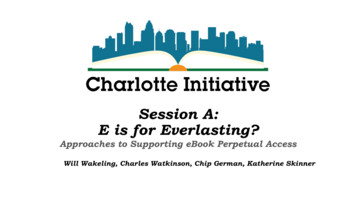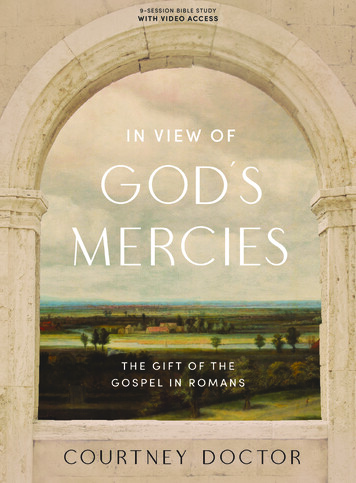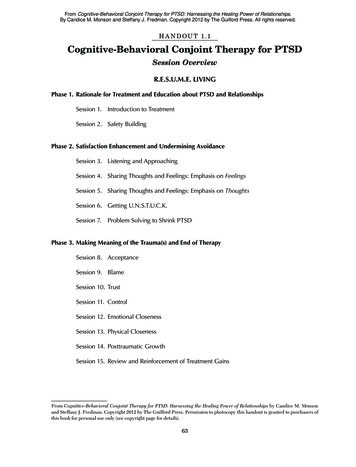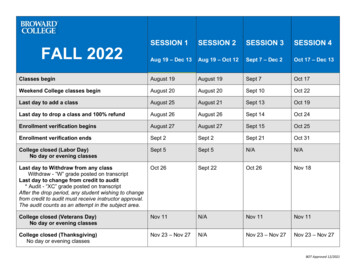
Transcription
Session A:E is for Everlasting?Approaches to Supporting eBook Perpetual AccessWill Wakeling, Charles Watkinson, Chip German, Katherine Skinner
perpetual, adj., adv., and n.1.a. Lasting or destined to last for ever, eternal; never ending or ceasing. Also: for the duration of aperson's lifetime; (of a position, office, etc.) held or occupied until death, appointed for life;permanent.b. Chiefly Law. That serves or remains applicable, valid, or in force for ever, or for an indefinite orunlimited period; given or paid in perpetuity; irrevocable.c. Finance. Of an investment: having no date of maturity, having the potential to continue indefinitely.2.a. Continuing or continued in time without interruption or remission; repeated frequently orwithout cessation; occurring in endless succession; persistent; continual; constant.[OED]
CI Platform and Preservation Research Team: Program Identification of Best Practices in licensing terms for perpetualaccess and local preservation Survey of current academic library eBook preservation strategies Review of third party eBook preservation solutions (Portico,CLOCKSS, etc.) Considerations for creating your own eBook preservation platform
CI Survey of Academic Library eBookpreservation strategies - early impressionsN 69 so far 58% of identifying libraries are in Carnegie Classification “doctoral” universities 20% Collections budget 500,000, 11% Collections budget 10M eBook spending as % of collections budget ranging from 1.24% to 65%; average 11.6% Size of eBook collections ranging from 10% of libraries with 50,000, 30% 500,000 20% of libraries purchase almost all ( 90%) of their eBooks via consortia. 30% purchasealmost none ( 5%) via consortia.
Only 10% of respondents required a Perpetual Access provision in their eBook licenses.(But DDS evidence and leasing rather than outright purchase can make a difference) “Do you track the preservation status of items in your eBook collection in any way (i.e.whether you have Perpetual Access, where or how the items are being preserved,etc.)?”15% Yes42% No43% Sometimes[when “Yes”, 55% do it @ collectionlevel, 45% @ item level] Only 5 libraries (7%) track whether individual items are held anywhere (locally or by 3rd partyservices) in a preserved format Only 8 libraries (12%) have policies/programs covering long-term preservation of theireBooks.
30 libraries (43%) indicated reliance on 3rd party preservation services (Portico, Hathi,CLOCKSS, Scholars Portal, etc.) 6 libraries (9%) indicated they were using “local” repository solutionsComments:“Currently we rely on the vendor for PA”“We subscribe to Portico to give us some peace of mind”“Apparently we need to put more thought into this area”“Since we rely on subscriptions we assume that EBSCO, Proquest, and others are addressingthese issues on their eBooks as part of their business models”“Seems like it really needs to be a collaborative effort. A distributed ebook repository. But effortslike Portico and Hathi are an important contribution”
Big QuestionsWho has rights?What is one preserving?How much is one preserving?How can you afford preserving? Who has responsibility?How much duplication is necessary or desirable?Perpetual Access vs Preservation?
U of M Press: A Typical UPUMP ServersPreservationDAM SystemDRM-free vendor
U of M Press: UP in a Library ContextUMP ServersPreservationDAM SystemDRM-free vendor
Challenges of Current System1.Partial coverage: Typical UP workflow may only include books forwhich ebooks are created for sale and moreover only the subsetsent to DRM-free vendors. So potentially only these enter Portico.2.Derivative versions: Flat PDFs go to JSTOR and Muse. HathiTrustconverts PDFs to image files. What about EPUB files? (U-M Librarynow working on workflow to ingest EPUB into HathiTrust)3.Challenge of non-textual formats: Many books currently haveredacted images. What about embedded multimedia? Morecomplexity is coming, e.g., books as apps, structured data,interactive narratives
University of Michigan Press: The Future?UMP ServersPreservationDAM SystemDRM-free vendor
Library’sCurrent E-booksUVA and APTrustPreservation of access to acquired e-books:We’ve got this covered, right?Dedicated DigitalPreservation
UVA and APTrustUVA Library Collection includes about 400K e-books 75 percent are subscriptions (varying need for PCA) Remaining 100K: licenses vary wildly re perpetual access Many acquired through consortium licenses (not UVA negotiation) Preservation to assure access has been mostly an afterthought Lots of work to do to be sure of the license provisions of what wealready have
UVA and APTrustAPTrust (aptrust.org) Consortium of 16 research-university libraries; headquarters at UVA Bit-level preservation environment Concept of lots of copies (3 on east coast, 3 on west coast, APTrustprocesses check fixity every 90 days) by higher ed for higher ed Amazon Web Services on back end (content is managed by our software,not Amazon’s) Additional service providers in future Each institution determines content deposited, and each assures
Library’sCurrent E-booksUVA and APTrustComponents missingbut needed forpreservationof accessDedicated DigitalPreservation
UVA and APTrustSo what’s missing for us?
UVA and APTrustSo what’s missing for us?It isn’t the technology (at leastnot the core functionalityneeded for digital preservation,which we have throughAPTrust, Hathi, DPN, andmany other similar efforts).
UVA and APTrustSo what’s missing for us? Clear idea of what access we want to preserve (not just PDF) Hard to think ahead 10 years when recovering from not fully realizingwhat we needed to do for the last 10Content SoftwareEqualsPreservation of Access
UVA and APTrustSo what’s missing for us? Clear understanding of level at which we want to preserve it Not just about “to preserve or not to preserve”All e-books are not equal(in deserving preservation of access).[But, it would take much less time to preserve access if they were.]
UVA and APTrustSo what’s missing for us? Sufficient leverage in negotiation to get appropriate license terms Do we have to all buy together, or can we just buy the same way? Push to help openness make dents in the market should help leverage. Then, the hard part: What should we acquire in an e-book (Charlotte Initiative principles) Perpetual access and archiving rights Unlimited simultaneous users
UVA and APTrustSo what’s missing for us?ENOUGH MONEYOur strategies: Get more (wish us luck with that) Reduce the amount needed Eliminate ineffective redundancy (through ideas like Keepers Registry) Collaborate (one-off solutions cost more)
Digital PreservationIngestFormat ValidationFixity CheckingAuditStorageGeographic ReplicationAccess Repair Data WranglingMetadataTestingTrustRights(etc.)“The series of managed activities necessary to ensurecontinued access to digital materials for as long asnecessary.” - Digital Preservation Coalition24
25
University Library Publishers’ Reported Preservation Platforms201520162017(124 respondents)(115 respondents)(118 202ScholarsPortalin-house050453552under discussionnone502461412
To look at that through another lens In rchive20162017
29
Think about all of the variationsetc
Preservation is not a one-time activityIt is an ongoing process
60 libraries and museums in three nations preserving morethan 1180 collections (totaling more than 80 TB) together in aPrivate LOCKSS Network environment.20042017
And a final hat Software Preservation Network (consulting)
Call to Action MAKE PRESERVATION PART OF THE WORKFLOW Meet publishers where they live, e.g., integrate with BiblioVault and CoreSourceExpand opportunities and make it easy for publishers to deposit into HathiTrust KEEP PRESERVATION PRESENT IN LICENSINGNEGOTIATIONS Get licensing right (or as right as you can)Work (and collaborate) to make your preservation strategy financially sustainable:no one pays once to preserve GET STARTED. NOW. Inventory your digital publication collections and ID what you’re not preservingEstablish bit-storage method that includes at least four separate copies andlocations for vulnerable collectionsWork in communities of practice; don’t seek “one-size-fits-all” solutions
58% of identifying libraries are in Carnegie Classification "doctoral" universities 20% Collections budget 500,000, 11% Collections budget 10M eBook spending as % of collections budget ranging from 1.24% to 65%; average 11.6% Size of eBook collections ranging from 10% of libraries with 50,000, 30% 500,000











